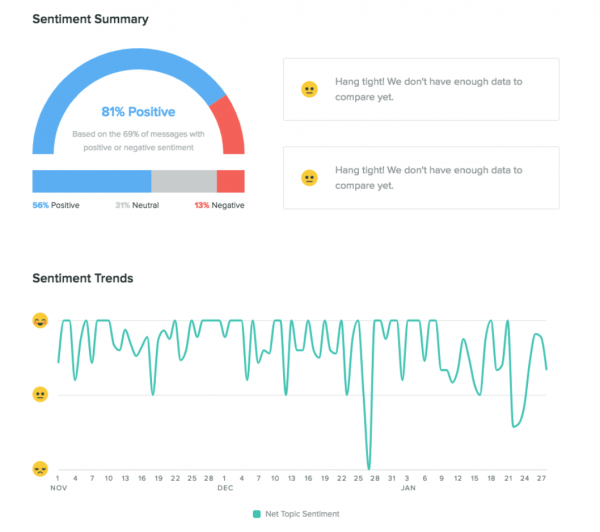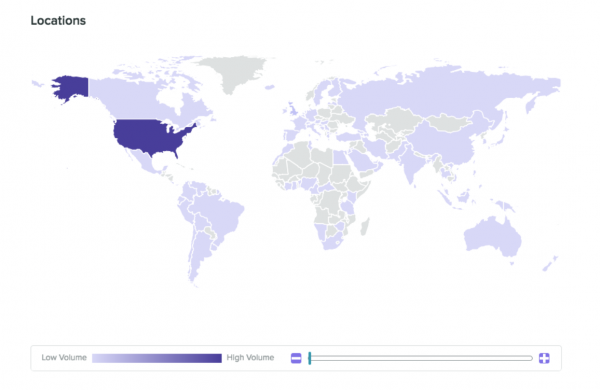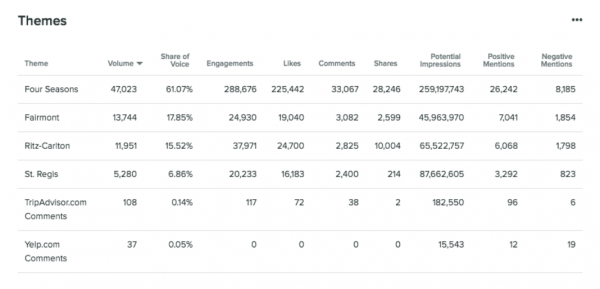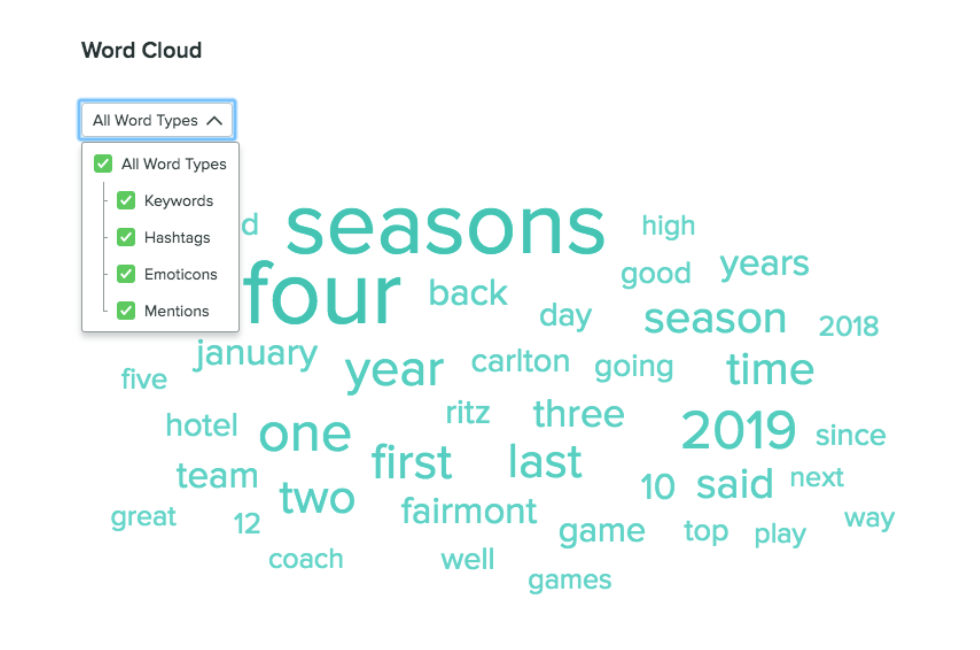Social listening strategies
Have a question about your own product, customers or competition? Odds are, social listening can help you find your own answer. To spark some ideas, we’ ve shared some of the top techniques we see customers using to get value with social listening.
Social listening for brand name intelligence
Before you expert over the hedges at your competitors’ interpersonal strategy, think first about having your own house in order.
By running social listening for your own personal organization, you can identify common client questions, comments, complaints, demographics and general sentiment around your brand name, and easily share that information with the rest of your team.
Once you start sharing your social listening data, you can do these tactical things right away.
- Find your own most frequently asked questions.
And create a FAQ document or even chatbot to help answer questions in scale. - Discover your customers’ most common issues.
And figure out how to solve these issues or create talk tracks to respond quickly. - Figure out what your customers love regarding you.
And influence that information to build campaigns or even content you know will resonate. - Identify your important social media customers.
And figure out how you can utilize their traits to focus on new social audiences. - Get a sense of whether followers are positively or negatively mentioning your brand.
If it turns out they skew a lot more negative, figure out if those are issues with your social media presence or something you can surface to other areas of your organization, like your product or activities teams.
You may also zoom out and look at your customers’ general sentiment.

From the thousand feet up, are your clients happy? If not, you may need to pivot your own strategy.

It’s clear to see which days this organization fell out of favor with their customers. Drill into those particular days to see what went wrong and learn how to avoid that happening again.
If you find that negative thoughts stem from issues outside of your pervue, then it is critical to share this information internally. Create entire reports for the team that show why your audience is unhappy and how disappointed that makes the social teams.
Show them anything that may help them identify and remedy a bad scenario, like the main themes, keywords, viewers and even locations. While it may seem insignificant to you, it could lead your item team to a major “aha” moment.

Social listening with regard to competitive intelligence
Social media is a competitive channel for brand names.
Now imagine you can keep track of everything individuals are saying about your competitors online. With social listening you are able to:
- Obtain a sense of your share of the social media audience. And be familiar with volume of your messages vs . their own.
- Understand why their customers may not be satisfied with their item. And how you could make a better experience.
- Find the content they share that outperforms your own. And analyze why it resonates along with your shared audience.
- Quickly identify the new products or even solutions they are offering. Find out what the general market sentiment is towards those products and solutions, and place a goal to outperform them.
Let’s say you’re working at a brand new luxury hotel chain set to interrupt the current leaders. In such a well-established market you need insights into what the market is saying about the big players so that you can take advantage of any shortcomings.

Drill down deeper into the top competitors to discover the most frequently discussed topics to assist inform your competitive content strategy.
 Dissect this data to look at keywords, hashtags, emoticons and more. Then dig directly into each specific leading phrase to determine why it’s so popular and exactly how you can leverage those insights in order to influence your own campaigns.
Dissect this data to look at keywords, hashtags, emoticons and more. Then dig directly into each specific leading phrase to determine why it’s so popular and exactly how you can leverage those insights in order to influence your own campaigns.
Social listening for industry intelligence
Social listening can help you pick up on industry trends before they become trends. By obtaining a sense of where your marketplace is headed you can create items, content and general messaging which will become a key talking point because trends develop.
Dynamically adapting to your industry sets a person leaps and bounds ahead of rivals.
- Keep an eye on anything disrupting the space that may impact your business.
- Track key politics and social issues to consider in on if they’re relevant to your brand.
- Find gaps in the market that a new product, solution or work flow could solve.
- Search for frequently asked questions to create content your audience needs.
An excellent example of this comes from the rapidly rising eSports industry. ESports groups and websites are consistently searching for the next big streamer or sport to add to their arsenal.
With social listening, they can discover those up-and-comers before anyone else.
Here you see the leading games, using some tweaks to the listening inquiries, you can find the top gamers. You can also fine-tune the sorting to see who is increasing through the eSports ranks.
Social listening for campaign insights
Brands spend a good deal of their time coming up with new strategies to launch, but without regard to whether or not that campaign succeeded, they have no information about how to improve or even build upon those efforts.
Listening tactics boost your advertising campaign success dramatically. Think through the following features for your next campaign.
- Track the impressions and engagements around your campaign content.
- Quickly gather common sentiment around specific campaigns.
- Identify the top influencers talking about your campaigns.
- Realize which of your audience demographic the campaign resonates with.
- Figure out the key themes within the marketing campaign that are being used and whether all those are positive or negative.
- Track collaborative campaigns from the single source of truth.
Social listening can finally prove to you the value of your marketing and advertising campaigns. Crafting listening topics in order to capture all of the conversations around your own campaign hashtags or handles offers insights into countless metrics.
You can then break down all of these insights simply by:
- Network
- Content type
- Message type
- Sex
- Age
- Sentiment
Social listening for content strategy
Your audience is much more likely to appreciate and share your content if it resonates with them. But you don’t usually know what will resonate with your target audience.
While many marketers turn to keyword research to figure out what will receive the most traffic in Google, figuring out conversations taking place on social shows you topics just before they become popular, giving you a leg up on competitors.
- Identify the top types of articles your audience engages with and use that to build your content strategy.
- Look through typical themes within your industry to create articles that will resonate.
It’s clear that content close to preferred training methods, what kind of gear to use and general nutrition would be valued by the audience.
Interpersonal listening for customer service
While social media monitoring allows you to easily respond to customer questions, social media listening uncovers trends in those problems.
By finding the main issues that customers have, you make a better overall customer service experience and minimize the number of inbound complaints.
- If you experience the spike in messages, dig through the trends in all those conversations to see what happened.
- Work to fix what happened. If the issue is out of your control, develop a communication strategy.
- Find the most frequently utilized keywords and hashtags receiving problems. Closely follow the developing narrative.
- Talk about information internally on the top locations and demographics. Send communications to help pinpoint issues.
One example is the NFL. Given the high-intensity nature of professional sports, any sort of bad call, skipped catch or poor throw may explode on social media. Not to mention the particular deeper and more concerning conversations about player health and social issues.
The NFL’s customers are, in essence, every single person who currently or may watch a game somewhere down the line. If the leagues and individual teams aren’t quickly identifying and engaging with those important messages, they may lose out on that target audience.
Listening can also reveal opportunities to surprise and delight your fans for increased exposure and brand loyalty.
The @Saints and @Cantguardmike personally sent the fan his signed jersey following the one she purchased was taken last week ⚜ ️ pic. twitter. com/V65xDZT68v
— ESPN (@espn) January thirty, 2019
And, of course , we have to throw one out there for our home team.
The Bears took advantage of a local polar vortex to sports a new name and share social posts to raise awareness about the dangerous frosty front.
By listening to their particular target audience, the team was able to create content that resonated with their supporters.
Social listening for product research
Say you’re tasked with establishing new menu items for a string of fast-casual restaurants. How can you include data with your own personal creativity?
Social listening provides a jumping-off point for finding products or services that your clients are hungry for.
While many companies keep track of Twitter conversations to identify a problem (such an airline responding to customer issues with a delayed flight), innovative companies are determining trends and insights that drive new product development. A packaged goods company, for example, can use Twitter information to reveal changing consumer preferences for new flavors, informing the advancement and marketing of new beverage choices.
Diana Helander
Head associated with Marketing, Data and Enterprise Options at Twitter
- Track user sentiment across your major product lines. Consider expanding those that are most well received and contracting those that aren’t.
- Monitor conversations around your major competition. Identify products their customers clamor for that they won’ t create.
- Track conversations across your entire market. Find out the latest companies features your customers want.
A craft beer business could follow the industry to see exactly what recipes and styles are in favor and showcase their products in that category— or even get to work on a new recipe.
Even finding one single nugget info on how to move your product ahead offsets the time and cost used on social listening.
Interpersonal listening for influencer marketing
Influencer marketing is the procedure for promoting and selling products or services via individuals capable of driving action from the target audience. Though influencer marketing isn’t a new concept, it has been becoming more popular with the rise of social superstars.
While you may not understand all of the major influencers in your business, you likely know how much it may cost to get your message out. It’s the most prominent example, yet Kylie Jenner makes an estimated $1 million per compensated Instagram post .
For organizations that don’t have that much to spend on their entire marketing and advertising budget, the idea of micro-influencers has become ever more popular.
This is the concept of finding smaller influencers who are more niche to your business.
- Find your present top influencers and figure out how to encourage them to continue to advocate for you.
- Find all of the influencers within your industry and create a list of those you might want to work with.
- Find your competitor’s top influencers plus attempt to win them over.
- Figure out the best social networks for the influencer marketing and create more articles for those channels.
Let’s say that you’re are a craft beer organization and wish to find all of the top YouTube influencers to partner with on your next item launch. Listen to the industry and find out who might be the most engaged beer influencer and partner with them to increase your reach.


